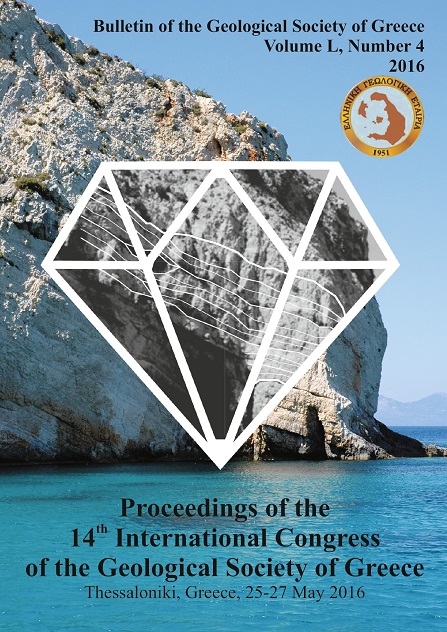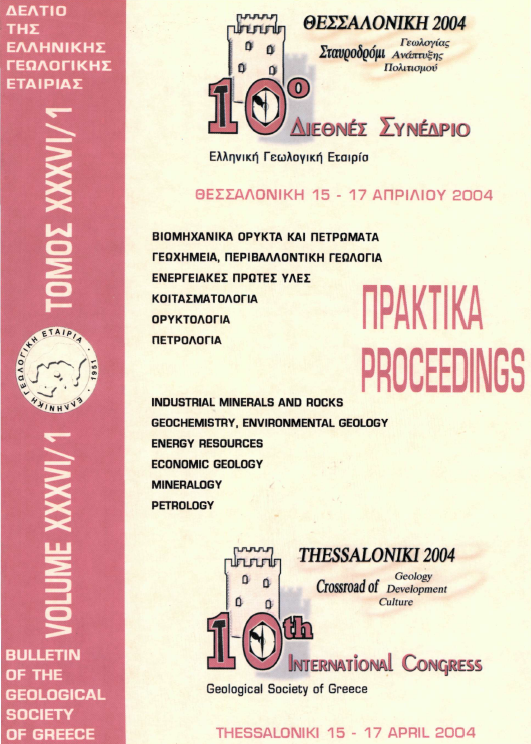Pétrographie characterization of rocks from the Mirabello bay region, Crete, and its application to Minoan archaeology: the provenance of stone implements from Minoan sites

Περίληψη
Οι άνθρωποι της Μινωικής Εποχής, στην Ανατολική Κρήτη, χρησιμοποιούσαν μαγματικά και μεταμορφωμένα πετρώματα για την κατασκευή διαφόρων λίθινων σκευών. Αυτά τα συνέλλεγαν από τις κοίτες των ποταμών και την ακτή στην περιοχή κατά μήκος του κόλπου του Μιραμπέλλο ή από ένα κροκαλοπαγές επίκλυσης, το οποίο κυριαρχεί γεωλογικά στην περιοχή αυτή και περιέχει κροκάλες από μαγματικά, μεταμορφωμένα και ιζηματογενή πετρώματα. Η λεπτομερής πετρογραφική περιγραφή φυσικών δειγμάτων, που συλλέχθηκαν από αυτούς τους σχηματισμούς και η σύγκριση τους με λίθινα σκεύη από ανασκαφές, αφενός καθιστά γνωστούς τους λιθολογικούς τύπους που χρησιμοποιήθηκαν και αφετέρου επιβεβαιώνει την πηγή προέ?χυσής τους. Με τη έρευνα αυτή καθίσταται προφανές ότι οι άνθρωποι της Μινωικής Εποχής μπορούσαν μα εκτιμήσουν τη σκληρότητα των λίθων που συνέλλεγαν, σύμφωνα με την επιθυμητή χρήση, καθώς και την αναμενόμενη κόπωση των υλικών, ανάλογα με τη χρήση για την οποία τα προόριζαν, αποφεύγοντας παράλληλα την ανεπιθύμητα χρονοβόρα κατεργασία τους. Με την επιβεβαίωση της λιθολογίας και της πηγής προέλευσης των λίθινων πρώτων υλών γίνεται επίσης αντιληπτό το γεγονός ότι οι άνθρωποι της Μινωικής Εποχής ήταν γνώστες του φυσικού περιβάλλοντος, στον ευρύτερο χώρο των οικισμών τους. Επίσης, μπορεί να εκτιμηθεί και ο χρόνος τον οποίο διέθεταν προκειμένου να βρουν και να συλλέξουν την πρώτη ύλη αλλά και να αξιολογηθεί ο χρόνος κατεργασίας των υλικών, προκειμένου να διαμορφωθούν σε κατάλληλα σκεύη, ανάλογα με τη σκληρότητα τους.
Λεπτομέρειες άρθρου
- Πώς να δημιουργήσετε Αναφορές
-
Dierckx, H. M., & Tsikouras, B. (2007). Pétrographie characterization of rocks from the Mirabello bay region, Crete, and its application to Minoan archaeology: the provenance of stone implements from Minoan sites. Δελτίο της Ελληνικής Γεωλογικής Εταιρείας, 40(4), 1768–1779. https://doi.org/10.12681/bgsg.17123
- Ενότητα
- Geosciences and Culture

Αυτή η εργασία είναι αδειοδοτημένη υπό το CC Αναφορά Δημιουργού – Μη Εμπορική Χρήση 4.0.
Οι συγγραφείς θα πρέπει να είναι σύμφωνοι με τα παρακάτω: Οι συγγραφείς των άρθρων που δημοσιεύονται στο περιοδικό διατηρούν τα δικαιώματα πνευματικής ιδιοκτησίας επί των άρθρων τους, δίνοντας στο περιοδικό το δικαίωμα της πρώτης δημοσίευσης. Άρθρα που δημοσιεύονται στο περιοδικό διατίθενται με άδεια Creative Commons 4.0 Non Commercial και σύμφωνα με την οποία μπορούν να χρησιμοποιούνται ελεύθερα, με αναφορά στο/στη συγγραφέα και στην πρώτη δημοσίευση για μη κερδοσκοπικούς σκοπούς. Οι συγγραφείς μπορούν να: Μοιραστούν — αντιγράψουν και αναδιανέμουν το υλικό με κάθε μέσο και τρόπο, Προσαρμόσουν — αναμείξουν, τροποποιήσουν και δημιουργήσουν πάνω στο υλικό.






